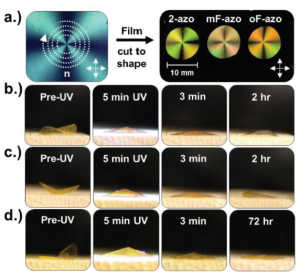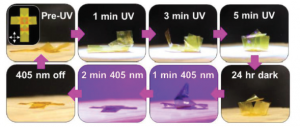Observing a flat sheet of material being folded into a box hardly quickens the pulse. Watching the same thing done using only light is a different matter.
In recent years, considerable research has been done on materials that undergo light-induced transformations, with an eye to applications in robotics, artificial muscles, and sensors. Previously reported materials have a range of limitations, including a tendency to revert back to their previous shape. A team from the US, however, have designed a material that can hold its shape for an extended period of time.

Design schematic and transition into a cone shape.
The energy required to deform this material comes from the isomerization of specialized functional groups within its structure. This isomerization causes the shape of the molecules bound to these groups to change. If those molecules have been aligned appropriately during fabrication, the shape change creates tension in the material.
The newly reported material is designed such that its molecules are aligned in a circular fashion around a central point (see right). When light of an appropriate wavelength is shone on the material, the tension created causes it to warp into a cone shape. This type of design has been demonstrated before, but in this case, careful choice of building block and synthesis strategy mean that once warped, the material stays in shape for up to 72 hours.
In a final test, the team demonstrated that the material could be used for origami (see below). Shining light of one wavelength on the flat material gave a box shape after five minutes. The box held its shape for 24 hours, before light of a second wave length almost instantly flattened the material again.

The shape-shifting cycle.
The team hoped that the robustness demonstrated by their design, and the fact that it can be readily molded with light, may lead to new applications for this type of material.

















